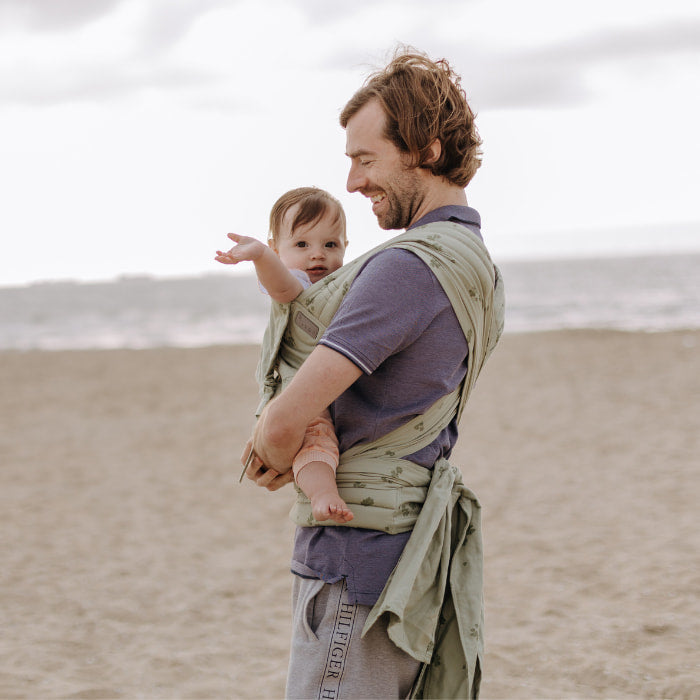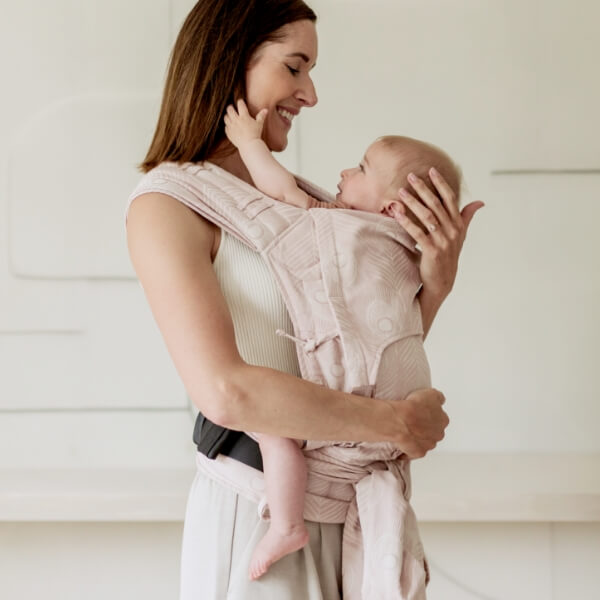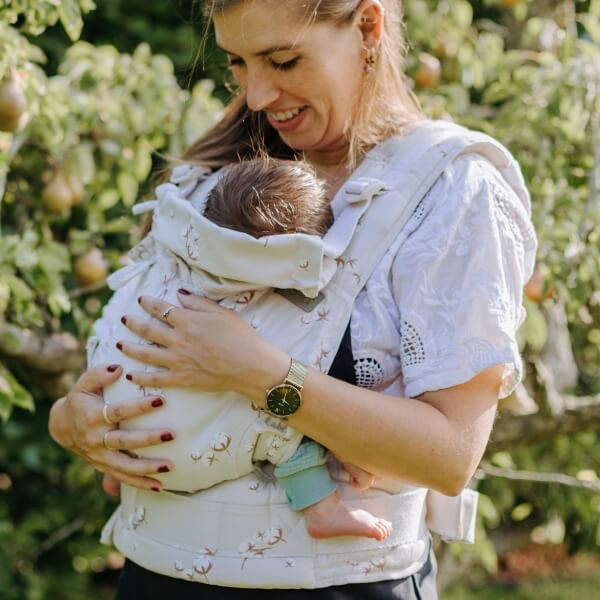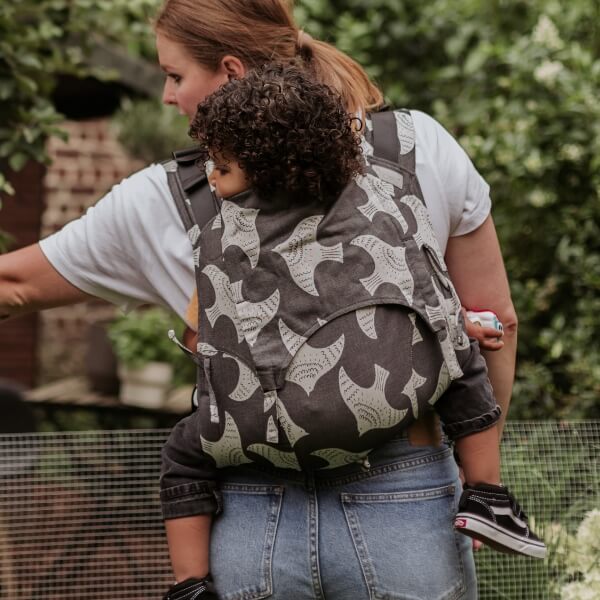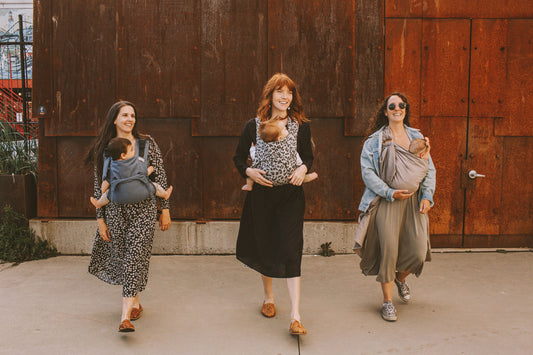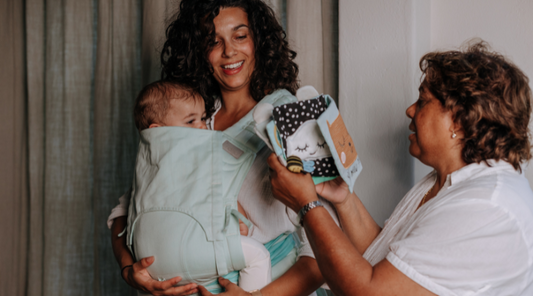Bettina Attenberger is one of the luminaries in the German-speaking world for carrying babies and children and early childhood bonding. She is an occupational therapist, founder of the carrying school NRW, mother of two "borne" children and SAFE mentor. For more than twenty years she has not only been advising parents, but has also been training carrying counsellors at the carrying school NRW.
In this interview Ms. Attenberger explains the background of bonding as well as why and how carrying babies and children supports their development.
Topic: Attachment
We hear again and again that carrying or "babywearing" strengthens the attachment between mother and child. What exactly is meant by attachment?
B.A.: Babies are always born with an expectation of attachmentand a willingness to bond to other people. This attachment gives the newborn protection and security. Since human children are born immature, it is essential to have a caregiver for the further development of the child.
In mothers, attachment (the bond between parents and child) already arises during pregnancy, an inner bond of inner emotional attachment. In principle, however, the child's expectation of bonding can also be fulfilled by another caregiver, the father, grandparents, godparents.
The biggest difference in the attachment between child and mother or father is probably that the mother experiences the complete pregnancy and the father can only enter the picture after birth.
Can there be too much attachment? We hear again and again that the children become "clingy" or cannot separate themselves, and have difficulties in attaining a certain independence.
B.A.: For me, spoiling means taking everything the child can do away from the child. But that has nothing to do with attachment. Mastering life situations is a process. Parents must 1. perceive a problem, and 2. recognize and react. The learning process for the child is that the child learns that someone is taking care of its needs.
As a rule, it can be observed that children in whom the expectation of attachment was fulfilled, especially in the early childhood development process, actually become independent earlier, go through life more courageously because they know that they will find the support they need "at home". Every time, even if they fail, or if it doesn't work out as expected.
If attachment goes well, it can have many positive effects on subsequent development: Strengthening of e.g. resilience, basic trust, empathy. The first attachment experience is a fundamental experiential schema for subsequent relationships.
How does babywearing help to build attachment? What are the advantages of babywearing it in terms of attachment? Especially in comparison with other "transport options", such as a pram?
B.A.: Babywearing can help in many ways. The three most important areas that are essentially promoted are: physical closeness, sensitivity and eye contact. Wearing with skin contact has an additional positive effect. The formation of the hormone oxytocin is stimulated, which essentially has a prosocial effect and promotes positive social interaction.
When wearing, the full concentration is on baby and caregiver. The baby has the feeling of being in the right place, can exchange information via eye contact with the mother in situations of uncertainty, and knows immediately whether everything is in order.
What effects does babywearing have on the child and the parents? Keywords: feelings, hormones, violence prevention?
B.A.: Wearing has an impact on 3 important basic human senses: sense of balance, sense of touch and the sense of muscle control. Wearing promotes motor function and body awareness. As already mentioned, wearing is also essential for physical closeness and sensitivity. The constant eye and body contact e.g. with the mother gives the baby a feeling of protection and safety. Wearing also has a positive effect on parents. Above all, it strengthens their sense of competence. In addition, the formation of oxytocin while wearing promotes hormonal exchange, which leads to less stress for mother and child and creates a balanced everyday feeling - especially in premature babies.
Less stress in everyday life also means more mobility for new parents. They do not run the risk of isolation, but feel they can do something (for the child) and do something good for themselves.
Is the attachment between mother and child fundamentally different from that between father and child?
B.A.: The biggest difference in the attachment between child and mother or father is probably that the mother experiences the complete pregnancy and the father can only enter the picture after birth.
Basically, however, this is more of a social or cultural question for me. In Sweden, for example, fathers have paternity leave, i.e. fathers must take at least 2 months of the parental leave and receive an additional 10 days of special leave in the first 3 months after birth in order to integrate the fathers more closely into everyday family life. While in Germany we tend to educate as individualists, in other parts of the world a child grows into a community to become part of this society. These are different or different educational goals, but they do not have any negative influence on the attachment. As already mentioned at the beginning, every child is born with a willingness and expectation of attachment.
Does it make a difference who wears? Does wearing help to build a better bond - especially between father and child or even grandparents and child?
B.A.: Carrying is a good kind of tool for me, but - like so many things - no guarantee. It helps because I can take care of myself after birth and makes it easier to get used to this new situation, to the role of a parent. It can support me in organizing a new family life and help me to create a balanced well-being, because I can concentrate on myself and my child equally without developing a guilty conscience. It is always helpful to look for so-called co-wearers, so that fathers, grandparents or uncles and aunts can take care of the new addition to the family and fulfill their roles in the family.


